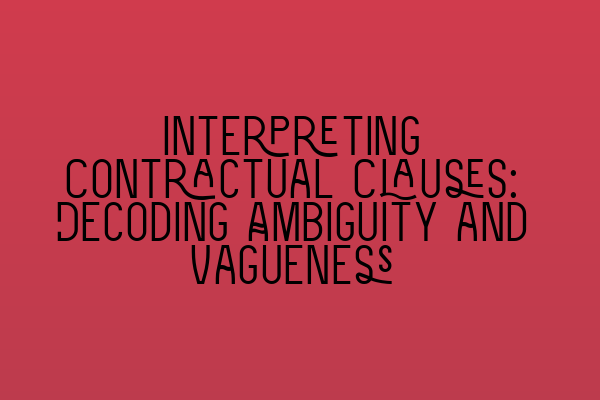Interpreting Contractual Clauses: Decoding Ambiguity and Vagueness
Welcome to SQE Contract Law! As solicitors, we understand the importance of interpreting contractual clauses accurately and efficiently. In this comprehensive guide, we will delve into the intricacies of decoding ambiguity and vagueness in contracts, providing you with valuable insights and professional expertise.
Understanding Ambiguity and Vagueness
Contracts are the backbone of any business transaction, outlining the rights and obligations of the parties involved. However, the language used in contract clauses can sometimes be ambiguous or vague, leading to confusion and potential disputes. Let’s take a closer look at what ambiguity and vagueness mean in a contractual context.
Ambiguity refers to a situation where a contract provision can be reasonably interpreted in more than one way. This can occur due to unclear or imprecise language, grammatical errors, or conflicting terms within the contract. Vagueness, on the other hand, arises when contract provisions lack clarity and precision, making it difficult to ascertain the intended meaning of the clause.
Both ambiguity and vagueness can potentially give rise to contractual disputes, as parties may have differing interpretations of their rights and obligations. However, with expert guidance and a thorough understanding of legal principles, these challenges can be overcome.
Best Practices for Interpreting Contractual Clauses
When faced with ambiguous or vague contractual clauses, it is crucial to adopt a systematic approach to interpretation. Here are some best practices to consider:
1. Contextual Analysis
Context is key when it comes to interpreting contractual clauses. Examine the contract as a whole to understand the overall purpose and intentions of the parties. Look for any definitions or stated objectives that may shed light on the clause in question. Additionally, consider any relevant surrounding circumstances, industry practices, or trade customs that could assist in determining the intended meaning.
For example, if a contract refers to “delivery time,” it is important to consider whether the parties intended “business days” or “calendar days” as the basis for calculating delivery time. Contextual analysis can help ascertain the correct interpretation.
2. Plain Meaning Rule
The plain meaning rule suggests that words should be given their ordinary or ordinary legal meaning. Unless the contract defines specific terms differently, words should be interpreted in their commonly understood sense. This approach ensures that the contracting parties are held to the objective intentions they expressed in their agreement.
However, it is important to note that the plain meaning rule is subject to context and the specific circumstances of the contract. If there is ambiguity or vagueness present, further analysis may be required.
3. Contra Proferentem Rule
Contra proferentem, Latin for “against the offeror,” is a legal doctrine that favors the interpretation of a contract clause against the party who drafted it. If there is ambiguity or vagueness in a contract provision, the provision is construed against the party who included it in the contract.
This rule places the burden on the party responsible for drafting the ambiguous clause to clarify its intended meaning. If the drafter fails to do so, they may be bound by an interpretation that is less favorable to their interests.
4. Consideration of Commercial Purpose
Contracts are entered into with a commercial purpose in mind. When interpreting contractual clauses, consider the underlying business objectives and the commercial reasonableness of a particular interpretation. This approach ensures that the contract is interpreted in a manner that aligns with the parties’ intentions and the practical realities of the business relationship.
5. Seek Professional Advice
Interpreting contractual clauses can be a complex task. When faced with ambiguity or vagueness, it is wise to seek professional advice from experienced solicitors like us at SQE Contract Law. Our expertise and knowledge can help clarify any uncertainties and ensure that you understand the implications of different interpretations.
Remember, contracts are legally binding documents, and the interpretation of their clauses can have significant consequences for your business.
Conclusion
Decoding ambiguity and vagueness in contractual clauses is of utmost importance to ensure a clear understanding of rights and obligations. By following best practices such as contextual analysis, applying the plain meaning rule, considering the contra proferentem rule, evaluating commercial purpose, and seeking professional advice, you can navigate through the complexities of contractual interpretation with confidence.
At SQE Contract Law, we offer expert legal services to assist you with all your contract law needs. Whether you require assistance in interpreting contractual clauses, drafting contracts, or resolving contractual disputes, our team is here to provide you with comprehensive support.
For more information on the SQE exams and preparation, check out our related articles:
- SQE 1 Practice Exam Questions
- SQE 1 Practice Mocks FLK1 FLK2
- SQE 2 Preparation Courses
- SQE 1 Preparation Courses
- SRA SQE Exam Dates
Contact us today to discuss your contract law requirements and benefit from our expertise in the field. Trust SQE Contract Law for all your legal needs!
